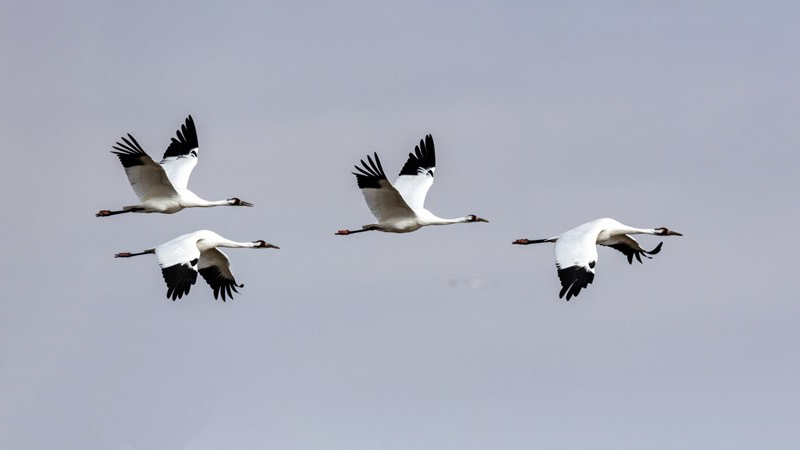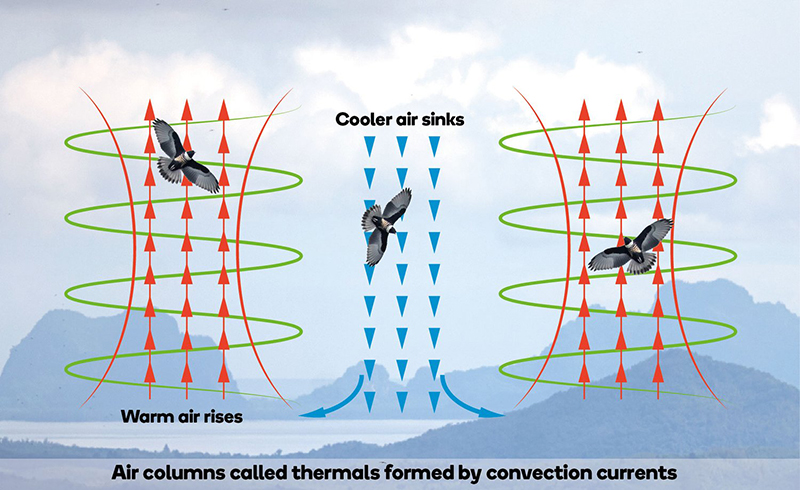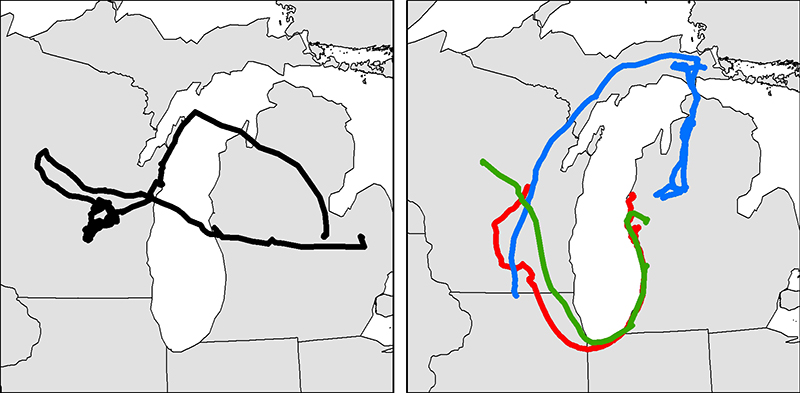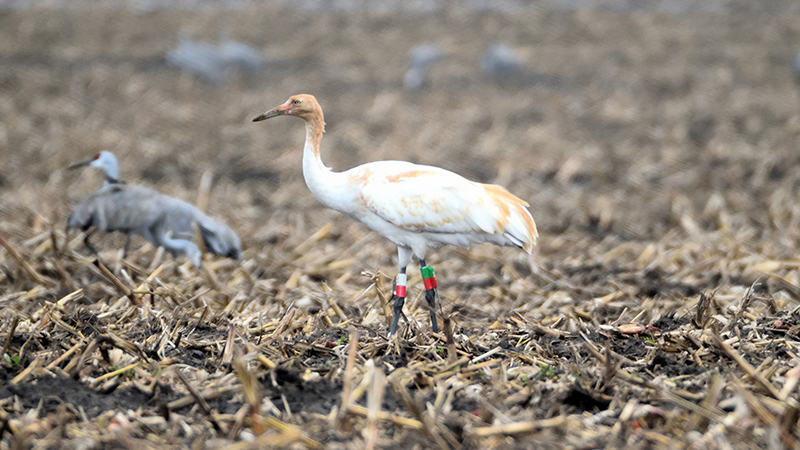
Cranes and other large-bodied waterbirds tend to migrate using soaring flight, relying on the thermal lift generated most strongly over land. They often fly around obstacles such as large bodies of water, which generate weaker thermals and provide less flight support. Here, however, we recount the first recorded case of a Whooping Crane flying directly over Lake Michigan.
When migrating, birds will reach their destination by soaring or flapping. During soaring flight, thermals, or circulating rising air, help birds gain altitude and move forward by gliding onto the next thermal. In comparison, thermals do not support flapping flight and are far more energetically expensive. For a large-bodied bird like a Whooping Crane, migration can be tiring, so energetically inexpensive soaring fight is favored. Thermals also tend to be strongest over land and during the day, further influencing Whooping Crane migration behaviors.

However, Whooping Cranes may encounter barriers during migration, such as large bodies of water that form weaker thermals with less support for soaring flight. When faced with this barrier, Whooping Cranes have a choice between flying around bodies of water and extending the length of their migration or using flapping flight to go straight over them. This can be a difficult or even unavoidable decision as Whooping Cranes demonstrate strong natal site fidelity, often choosing to return to the area where they hatched, even if that means expending more energy to circumnavigate or cross a barrier. Additionally, given the small population size of the Eastern Migratory Population (69 individuals as of June 2024), it’s important for breeding-age cranes to migrate to concentrated areas on the breeding grounds in Wisconsin where they can find mates and reproduce.
Most Whooping Cranes will return to Wisconsin using flight paths through Illinois, but in 11 recorded cases, they have flown north to Michigan before returning to Wisconsin. The majority of the time, Whooping Cranes flying between Michigan and Wisconsin have circumnavigated Lake Michigan and flown over land. In 2020, however, our team at the International Crane Foundation observed a male Whooping Crane, 72-17, fly over Lake Michigan twice within 29 days. On April 3, 2020, he flew westward directly over Lake Michigan, and his flight lasted between 108 and 120 minutes. Upon his return, he moved around central Wisconsin before returning to Michigan on May 2, 2020, flying directly over the lake again. His return route was shorter, with GPS data reporting a potential flight duration between 75-186 minutes. In both flights, there was no recorded precipitation. He had a tailwind supporting his flight, and a stronger tailwind was recorded on his second flight from Wisconsin to Michigan.

This observation is substantial because it tells us that flight over Lake Michigan and other large bodies of water is within the realm of possibility for Whooping Cranes during migration. However, without using thermals formed over land, this over-water movement likely required more energy-expensive flapping flight. So why did 72-17 choose to fly over Lake Michigan instead of around it?

Our team believes environmental conditions may have influenced this decision. During 72-17’s flight westward from Michigan to Wisconsin, easterly winds were present, and on his eastward route, westerly winds were present. Cranes likely prefer not to cross large water bodies during migration. Still, certain environmental conditions, such as strong tailwinds or winds in the direction of migratory flight, can make this journey possible. We also know that this behavior and decision-making influenced by favorable environmental conditions is not unique to Whooping Cranes. Other studies have documented Eurasian Cranes migrating across European seas, Demoiselle Cranes migrating directly over the Himalayas, White-naped Cranes flying across the Korean Strait, and a Sandhill Crane flying a similar route over Lake Michigan as was taken by 72-17.
This study has given our team more context about Whooping Crane migratory behavior. Still, in the bigger picture, we need to consider what this means for managing the reintroduced population. Due to the small population size of the Eastern Migratory Population, it is important that breeding-age adult cranes reside in concentrated breeding areas to find Whooping Crane mates to reproduce with and contribute to overall population growth. Therefore, while we have documented that it is possible for Whooping Cranes flying to Michigan in the spring to return to core breeding areas in Wisconsin by flying over or around Lake Michigan, it is also crucial for us to understand more about what is driving Whooping Cranes to disperse far from their natal sites and establish breeding areas outside of the core population, such as in Michigan, where there are presently very few potential Whooping Crane mates.
We thank Hillary Thompson and Lea Ratanawong, the authors of the paper “First Description of a Whooping Crane Flying over Lake Michigan,” for permitting us to share their work.
Story submitted by Lauren DeGere, Crane Conservation Intern, and Stephanie M. Schmidt, Lead Outreach Biologist, International Crane Foundation.
References: 1. Thompson, H.T., Ratanawong, L. R. (2022). First Description of a Whooping Crane Flying over Lake Michigan. Passenger Pigeon 84(1-2): 3-9.
